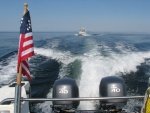Wayne McCown
New member
Twice, I have found myself in a situation where the wind was blowing our C-Dory up against the dock alongside. How does one get away from the dock in such a situation?
Once, I asked my wife to push off from the cockpit...which was the wrong thing to do! Pushing the stern away from the dock aimed the bow directly into it..and exacerbated our situation greatly (which, by the way, was my fault, not hers!).
I do have twin engines, and have wondered if they could be used (in the right combination) in such a situation?
Once, I asked my wife to push off from the cockpit...which was the wrong thing to do! Pushing the stern away from the dock aimed the bow directly into it..and exacerbated our situation greatly (which, by the way, was my fault, not hers!).
I do have twin engines, and have wondered if they could be used (in the right combination) in such a situation?

